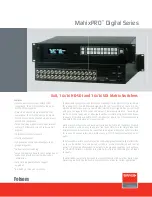
C
HAPTER
6
| VLAN Configuration
IEEE 802.1Q VLANs
– 158 –
Figure 58: Using GVRP
Forwarding Tagged/Untagged Frames
If you want to create a small port-based VLAN for devices attached directly
to a single switch, you can assign ports to the same untagged VLAN.
However, to participate in a VLAN group that crosses several switches, you
should create a VLAN for that group and enable tagging on all ports.
Ports can be assigned to multiple tagged or untagged VLANs. Each port on
the switch is therefore capable of passing tagged or untagged frames.
When forwarding a frame from this switch along a path that contains any
VLAN-aware devices, the switch should include VLAN tags. When
forwarding a frame from this switch along a path that does not contain any
VLAN-aware devices (including the destination host), the switch must first
strip off the VLAN tag before forwarding the frame. When the switch
receives a tagged frame, it will pass this frame onto the VLAN(s) indicated
by the frame tag. However, when this switch receives an untagged frame
from a VLAN-unaware device, it first decides where to forward the frame,
and then inserts a VLAN tag reflecting the ingress port’s default VID.
C
ONFIGURING
VLAN
G
ROUPS
Use the VLAN > Static (Add) page to create or remove VLAN groups. To
propagate information about VLAN groups used on this switch to external
network devices, you must specify a VLAN ID for each of these groups.
CLI R
EFERENCES
◆
"Editing VLAN Groups" on page 786
P
ARAMETERS
These parameters are displayed:
Add
◆
VLAN ID
– ID of VLAN or range of VLANs (1-4093).
Up to 256 VLAN groups can be defined. VLAN 1 is the default untagged
VLAN.
◆
Status
– Enables or disables the specified VLAN.
◆
Remote VLAN
– Reserves this VLAN for RSPAN (see
"Configuring
Remote Port Mirroring" on page 124
).
Port-based VLAN
1
2
9
3
4
10 11
12
13
14
5
6
7
8
15 16
18
19
Summary of Contents for ES3510MA
Page 1: ...Management Guide www edge core com 8 Port Layer 2 Fast Ethernet Switch...
Page 4: ...ABOUT THIS GUIDE 4...
Page 30: ...CONTENTS 30...
Page 40: ...FIGURES 40...
Page 46: ...TABLES 46...
Page 48: ...SECTION I Getting Started 48...
Page 72: ...SECTION II Web Configuration 72...
Page 88: ...CHAPTER 3 Using the Web Interface Navigating the Web Browser Interface 88...
Page 116: ...CHAPTER 4 Basic Management Tasks Resetting the System 116...
Page 154: ...CHAPTER 5 Interface Configuration VLAN Trunking 154...
Page 216: ...CHAPTER 8 Spanning Tree Algorithm Configuring Interface Settings for MSTP 216...
Page 350: ...CHAPTER 14 Security Measures DHCP Snooping 350...
Page 440: ...CHAPTER 17 IP Services Displaying the DNS Cache 440...
Page 484: ...CHAPTER 19 Using the Command Line Interface CLI Command Groups 484...
Page 554: ...CHAPTER 21 System Management Commands Switch Clustering 554...
Page 574: ...CHAPTER 22 SNMP Commands 574...
Page 582: ...CHAPTER 23 Remote Monitoring Commands 582...
Page 636: ...CHAPTER 24 Authentication Commands Management IP Filter 636...
Page 736: ...CHAPTER 29 Port Mirroring Commands RSPAN Mirroring Commands 736...
Page 816: ...CHAPTER 34 VLAN Commands Configuring Voice VLANs 816...
Page 830: ...CHAPTER 35 Class of Service Commands Priority Commands Layer 3 and 4 830...
Page 848: ...CHAPTER 36 Quality of Service Commands 848...
Page 900: ...CHAPTER 38 LLDP Commands 900...
Page 910: ...CHAPTER 39 Domain Name Service Commands 910...
Page 916: ...CHAPTER 40 DHCP Commands DHCP Client 916...
Page 948: ...CHAPTER 41 IP Interface Commands IPv6 Interface 948...
Page 950: ...SECTION IV Appendices 950...
Page 982: ...INDEX 982...
Page 983: ......
















































